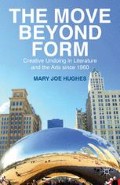Abstract
At some point in the twentieth century, works of visual art opened themselves up to movement, interaction, and transformation over time. Umberto Eco located this change within modernism. In The Open Work Eco argued that artists like Calder, Mallarmé, and Stockhausen left the arrangement of some of the constituents of their work to the public or to chance. In this sense the art form becomes a work in movement or progress. It does not prescribe a single point of view, even though, Eco assures us, the result always remains the “world” intended by the author. The author is the one who proposes the possibilities.1
Access this chapter
Tax calculation will be finalised at checkout
Purchases are for personal use only
Preview
Unable to display preview. Download preview PDF.
Notes
Umberto Eco, The Open Work, trans. Anna Cancogni (Cambridge: Harvard University Press, 1989), 22–3, 19. Originally published as Opera Aperta in 1962.
Claude Cernuschi, Jackson Pollock: Meaning and Significance (New York: HarperCollins, 1992), 139.
Burton Roeche, “Unframed Space,” in Jackson Pollock, Interviews, Articles and Reviews, ed. Pepe Karmel (New York: The Metropolitan Museum of Art, 1999), 18–19.
John T. Paoletti, “Art,” in The Postmodern Moment: A Handbook of Contemporary Innovation in the Arts, ed. Stanley Trachtenberg (Westport and London: Greenwood, 1985), 59.
Gary Shapiro, Earthwords: Robert Smithson and Art after Babel (Berkeley, Los Angeles, and London: University of California Press, 1995), 77.
Quoted in Michael Fried, “Art and Objecthood,” in Minimal Art, ed. Gregory Battcock (New York: Dutton, 1968), 125.
Jed Perl, “Postcards from Nowhere,” The New Republic (June 25, 2008), 37.
Nicolas Bourriaud, Relational Aesthetics (Dijon: les presses du réel, 2002), argues that contemporary art “takes being-together as a central theme, the ‘encounter’ between beholder and picture, and the collective elaboration of meaning” (15). As will be shown, I regard this as one instance of the move beyond form, but not its whole significance. Interactivity is important, but artworks are engaged in more philosophical meaning-making as well.
Robert Smithson, The Writings of Robert Smithson, ed. Nancy Holt (New York: New York University Press, 1979), 69.
Erin Hogan, Spiral Jetta (Chicago and London: University of Chicago Press, 2008), 135.
Jacques Derrida, “Différance,” in Margins of Philosophy, trans. Alan Bass (Chicago: University of Chicago Press, 1982), 11.
Craig Owens, “Earthwords,” in Beyond Recognition: Representation, Power, and Culture, eds. Scott Bryson, Barbara Kruger, Lynne Tillman, & Jane Weinstock (Berkeley, Los Angeles, and Oxford: University of California Press, 1992), 46–7.
Karen Rosenberg, “Richard’s Arc,” New York Magazine (May 17, 2007), www.nymag.com/arts/profiles/32110.
Carter Ratcliff, “The Fictive Spaces of Richard Serra,” Art in America (December 2007), 118.
Sol LeWitt, “Doing Wall Drawings,” in Critical Texts, ed. Adachiara Zevi (Rome: I libri di AEIUO, Incontri Internationale D’Arte, 1994), 95.
Walter Benjamin, “The Task of the Translator,” in Illuminations, trans. Harry Zohn (New York: Schocken, 1968), 73.
Geoff Edgers, “The Writing on the Wall,” Boston Globe (November 2, 2008), quoting the director of Mass MoCA, Joseph C. Thompson.
Alfred Frankenstein, in the San Francisco Chronicle, quoted by Alex Ross, The Rest Is Noise (New York: Farrar, Straus and Giroux, 2007), 540.
Jacques Derrida, “Living On: Border Lines,” in Deconstruction and Criticism, 84, cited in Brian Edwards, Theories ofPlay and Postmodern Fiction (New York and London: Garland, 1998), 216.
Jacques Derrida, Writing and Difference (Chicago: University of Chicago Press, 1978), 20.
Jacques Derrida, The Truth in Painting, trans. Geoff Bennington and Ian McLeod (Chicago: University of Chicago Press, 1987), 73.
Copyright information
© 2013 Mary Joe Hughes
About this chapter
Cite this chapter
Hughes, M.J. (2013). Transforming Space over Time: The Visual Arts. In: The Move Beyond Form. Palgrave Macmillan, New York. https://doi.org/10.1057/9781137329226_3
Download citation
DOI: https://doi.org/10.1057/9781137329226_3
Publisher Name: Palgrave Macmillan, New York
Print ISBN: 978-1-349-45656-7
Online ISBN: 978-1-137-32922-6
eBook Packages: Palgrave Literature CollectionLiterature, Cultural and Media Studies (R0)

